Archives
-
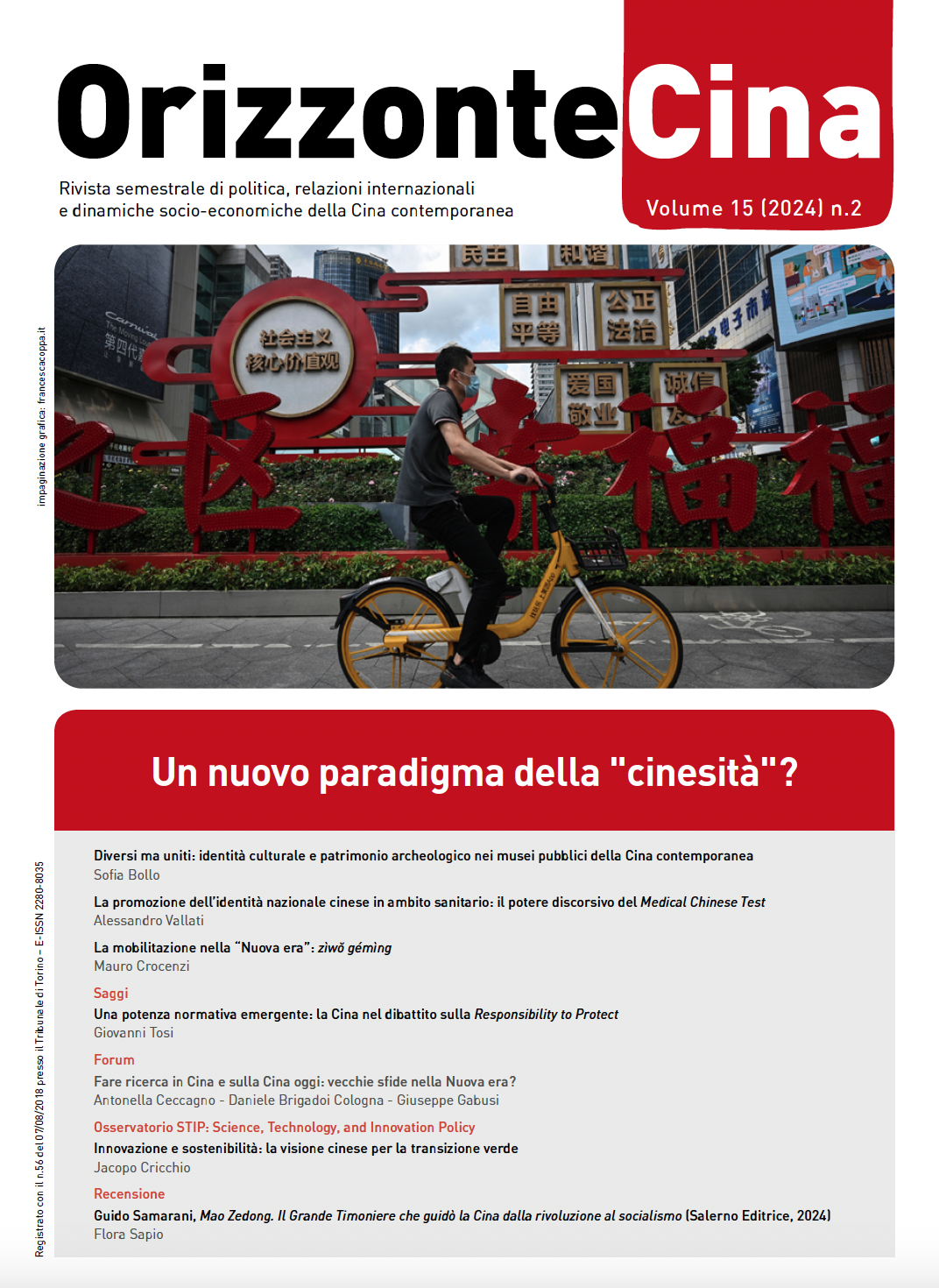
A new paradigm of "Chineseness"?
Vol. 15 No. 2 (2024)Post-pandemic China has undergone profound transformations, not only in its economic and political landscape but also in the construction of its national identity. While the reform era promoted a vision of "Chineseness" that was open and cosmopolitan, the so-called New Era has solidified a shift toward a more unified and prescriptive identity narrative. The call to "remember the original mission" of the Chinese Communist Party reflects a renewed effort to define and regulate the diverse expressions of Chinese identity, both within the PRC and across its diaspora communities. This issue of OrizzonteCina explores the emergence of a possible new paradigm of "Chineseness," examining its cultural, political, and institutional implications.
-
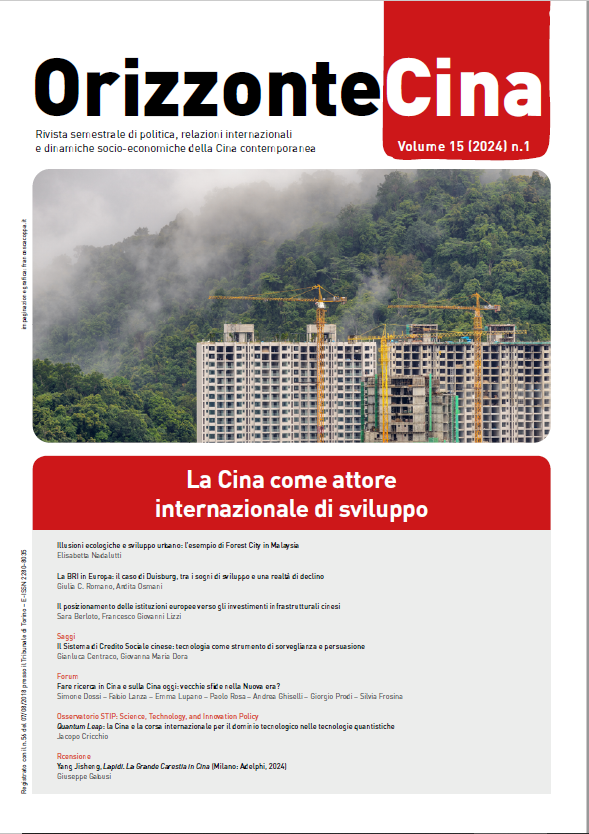
China as an agent of international development
Vol. 15 No. 1 (2024)Ten years after the launch of the New Silk Roads, this issue of OrizzonteCina explores the systemic implications of China’s growing role in global infrastructure development. Projects funded by Beijing, and often carried out by Chinese companies, have spread across many regions of the world, from Southeast Asia to Eastern Europe, from Sub-Saharan Africa to South America. These initiatives not only represent a continuity with the strategies of multilateral financial institutions but, in many cases, inherit their projects, altering their impact and dynamics. Through a detailed analysis, this issue aims to map the presence and distribution of Chinese investments in development, as well as assess their economic, social, and environmental effects at both national and local levels. Additionally, the issue includes a Forum titled "Conducting Research in and on China Today: Old Challenges in the New Era?", which discusses the problems connected to studying China today and explores potential solutions to address some of these challenges.
-
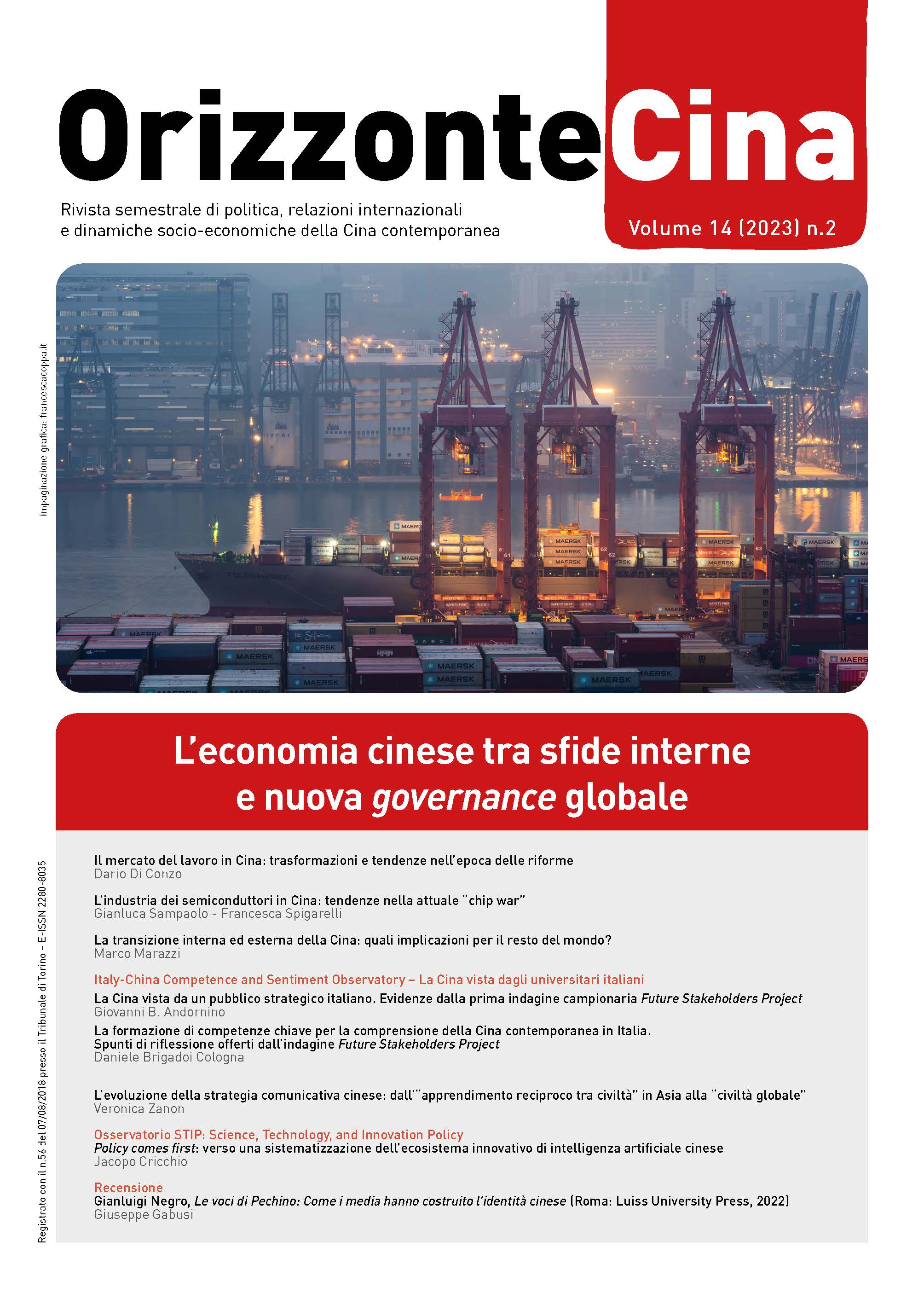
China's economy amid domestic challenges and the new global governance
Vol. 14 No. 2 (2023)Despite international tensions, the trade war between Washington and Beijing, and extended lockdown due to COVID-19, China's GDP grew by 5 percent last year. Despite widespread predictions of a de-coupling (decoupling) between the Chinese economy and the Western economic space, and despite some high-tech sectors undoubtedly experiencing a slowdown of the interplay, foreign investors' interest in the Chinese market continues to be relevant: during the days when Russia invaded Ukraine, Elon Musk announced the opening of a new Tesla plant in Shanghai. Mindful of the conclusion of a cycle of globalization, Xi Jinping has launched a strategy of "dual circulation," both internal and external, to create an economy less dependent on exports, and where domestic consumption can be a real driver of growth.
What is the true state of the Chinese economy? What domestic critical issues does it face? What are its strengths? How is China responding to U.S. pressure? The development dynamics of the Chinese economy and Beijing's contribution to global economic governance is the subject section of this issue of OrizzonteCina. The issue also features a second theme section, which investigates Italian university students' perceptions of China in light of a recent survey conducted by the Italy-China Competence and Sentiment Observatory.
-
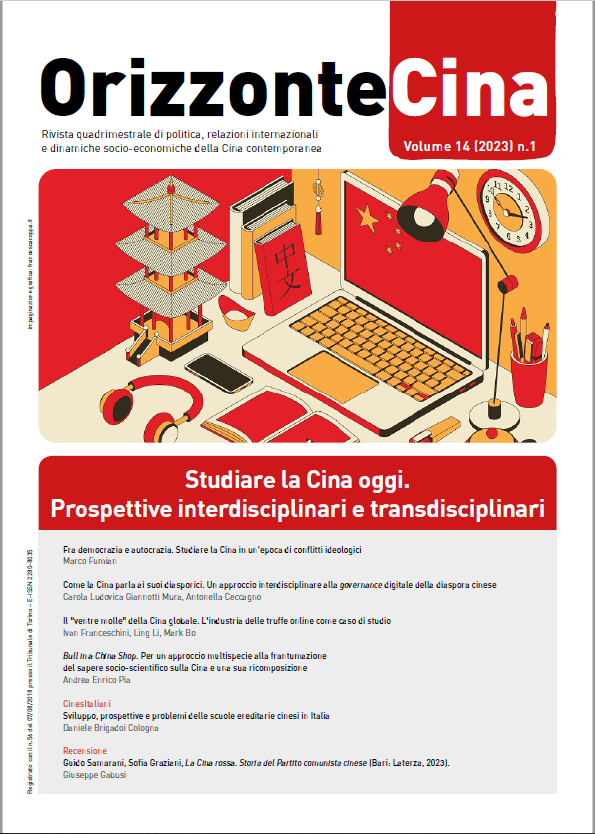
Studying China today. Inter- and transdisciplinary perspectives
Vol. 14 No. 1 (2023)The range of knowledge, experience and skills useful for understanding today's China is more articulated and complex than ever before. In addition to the necessary linguistic, historical and literary skills required to navigate the culturally oriented expressive and conceptual codes of the Chinese tradition, the ability to combine or temper them with training in different disciplinary fields, first and foremost those of the social sciences - political science, sociology, economics, anthropology and law - seems more vital than ever. What margins are there in Italy today for the construction of such knowledge?
-
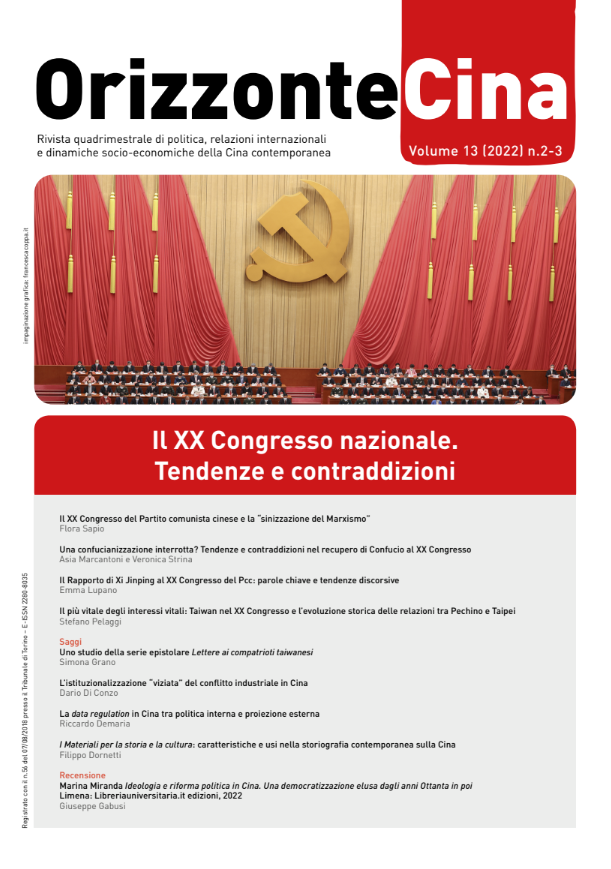
The 20th National Congress. Trends and Contradictions
Vol. 13 No. 2-3 (2022)The 20th National Congress of the Chinese Communist Party marked Xi Jinping's plenitudo potestatis. Confirmed as General Secretary for an unusual third term and surrounded by loyalists in the Standing Committee, Xi now appears to be embodying China's return to the old era of the paramount leader. The complex events of the past three years - ranging from the mounting tensions with the United States to the persisting state of pandemic emergency - do not appear, therefore, to have undermined the tendency towards the centralisation of power that has marked the 'New Era', since it was inaugurated in 2012. On the contrary international tensions and the internal state of emergency offered new leverages for centralisation. This is suggested by the ubiquitous reference to a spirit of 'struggle' (dòuzhēng 斗争), drawing the essential need to preserve the centrality of the leader from the image of a hostile external environment. In this sense, the joint visit of the newly formed Standing Committee to Yan'an is highly symbolic. It ostentatiously draws parallels between the recently concluded 20th Congress and the 7th Congress celebrated there in 1945, and by implication between Xi's and Mao's leadership. However, the objectively difficult environment creates new contradictions in the march towards the "great renaissance of the Chinese nation" (Zhōnghuá mínzú wěidà fùxīng 中华民族伟大复兴). Having accomplished the first 'goal of the century' along with the 100th anniversary of the Party's founding in 2021, it now remains to achieve the second goal: an articulated declination of the concept of 'Chinese-style modernisation' (Zhōnguó shì xiàndàihuà 中国式现代化), which is at risk of being severely affected by the slowdown of the Chinese and international economies, as well as the social tensions produced by the pandemic containment policies. Equally uncertain seem the ambitious goals of technological progress, especially in light of the additional sanctions recently imposed by Washington on exports to China. Not to mention concerns over the "most vital of all vital interests" – Taiwan. Whereas only a few years ago the ultimate goal of national reunification seemed achievable with ever closer economic integration, the island is now at the epicentre of international tensions that demand new strategic assessment. Similarly, new scrutiny is required over the reform of global governance to Beijing’s preferences, and endeavour increasingly affected by the growing competitiveness of the international environment and polarisation produced by the war in Ukraine. On these and other matters, the Congress documents provide small adjustments in the 'formulations' (tífǎ 提法), which perhaps foreshadow more significant policy changes.
-
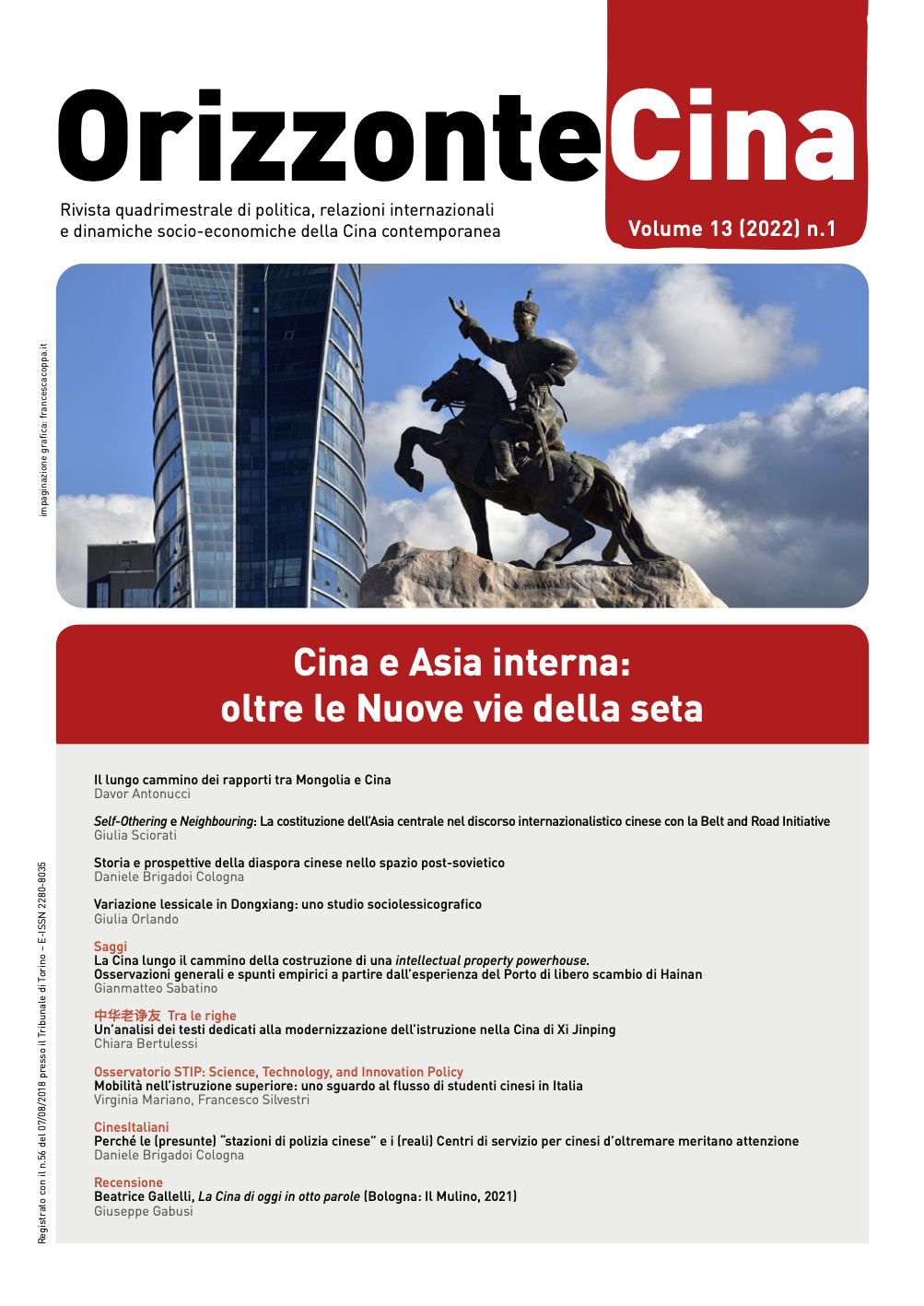
China and Inner Asia: beyond the New Silk Roads
Vol. 13 No. 1 (2022)The launch of the Belt and Road Initiative (BRI) in 2013 allowed China to extend its influence in Inner Asia, while counterbalancing aspirations for a zone of political and economic integration promoted by Russia - the Eurasian Economic Union, EAEU - with the clear intention of re-establishing its influence in the post-Soviet space. Inner Asia is therefore today the arena in which various actors, including the SCO (Shanghai Cooperation Organization), the European Union through the Eastern Partnership, but also NATO and the USA, try to expand and affirm their influence. Although BRI’s main objectives are the interconnectivity of transport, the financing of infrastructures, and the integration of financial markets, the actions undertaken also have profound implications in the social, environmental, and even linguistic fields. Up to now, people-to-people projects, which are also a pillar of the BRI, have received little attention in the allocation of funds, almost entirely destined to support economic and infrastructural interventions. Ten years after the launch of the initiative, it is time for a reflection on how these projects impact local communities and minorities which in Inner Asia also have cross-border relevance, as in the case of Uighurs, Kazakhs, or Tajikis present both in China and in neighboring countries. The ever more pervasive Chinese influence in these territories, for decades part or satellite of the Soviet Union, as in the case of Mongolia, has had important, but not unpredictable, repercussions also in the field of language policies and education. The religious dimension, which has historically served as a glue in these areas, effectively connects cross-border minorities - Mongols, Uighurs, Tajiks - outlining spaces for action and reaction to the increasingly accentuated control policies of the Chinese authorities.
-
First view
OrizzonteCina aligns itself with the best practices of international scientific journals by immediately publishing in digital preview the articles that have completed the peer-review process. These articles, paginated and provided with a DOI code, will be subsequently published as part of the appropriate volume and issue, with relative page numbering.
-
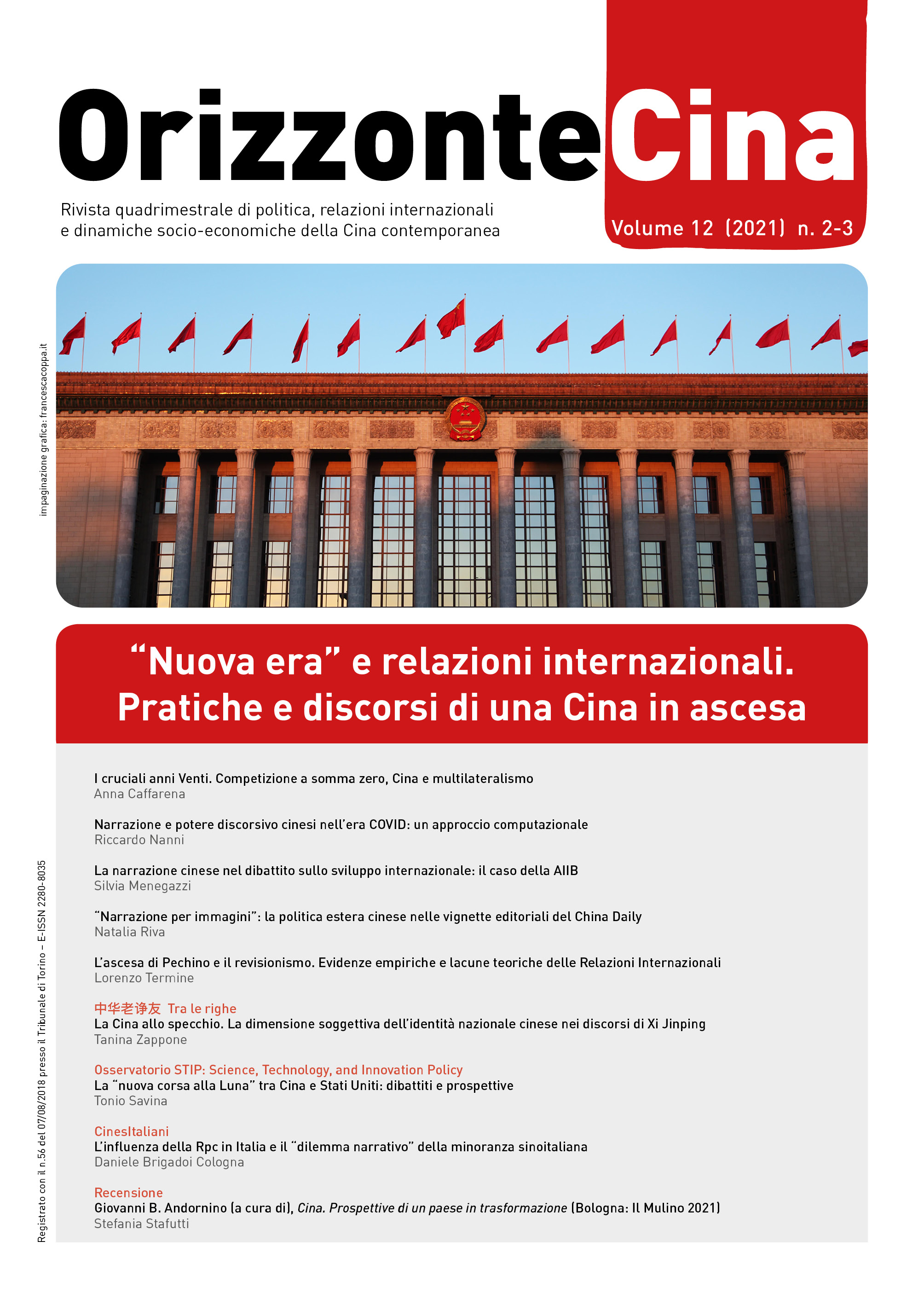
"New era" and international relations. Practices and discourses of a rising China
Vol. 12 No. 2-3 (2021)In the "New Era" of China, the search for adequate international status is an essential component of the processes of domestic political legitimacy. "Stood Up" (zhànqǐlai 站起来) in the era of Mao Zedong and "gotten rich" (fùqǐlai 富起来) in the era of Deng Xiaoping, Xi Jinping's China now aspires to internationally "get strong" (qiángqǐlai 强起来), thereby bringing to final fulfillment the "great rejuvenation of the Chinese nation" (Zhōnghuá mínzú wěidà fùxīng 中华民族伟大复兴) promised by the Communist Party. Today, the objective seems closer than ever, in an international context which - in the eyes of the Chinese leadership - is not only characterized by the prolongation of a "period of strategic opportunity" (zhànlüè jīyù qī 战略机遇期), but also by the manifestation of "unprecedented changes in a century" (bǎinián wèiyǒu zhī dabiàn jú 百年未有之大变局) such as to prefigure "the rise of the East and the decline of the West" (dōngshēng xījiàng 东升西降).
In this context, China's foreign policy action is characterized by an unprecedented ambition that seems to have now definitively dismissed - both in terms of practices and in terms of discourse - the "keeping a low profile and biding one’s time" (tāoguāng yǎnghuì 韬光养晦) of the old era. A line of greater intransigence can be seen in the practices and speeches of Beijing within the perimeter of its periphery, particularly with regard to territorial disputes as well as the ongoing Taiwan issue. At the same time, this unprecedented ambition characterizes China's projection beyond the traditional regional horizon. Thus, to the growing pressure exerted by the United States since the Obama administration, Beijing responds by articulating its own vision of the international order and claiming its own "discourse power" (huàyǔquán 话语权) in the global public space. In this sense, the Belt & Road Initiative (BRI) represents only the most visible manifestation of a more generalized China activism, aimed at shaping, adapting, or challenging norms, rules, and institutions of the liberal international order as well as globalized at the end of the Cold War.
-
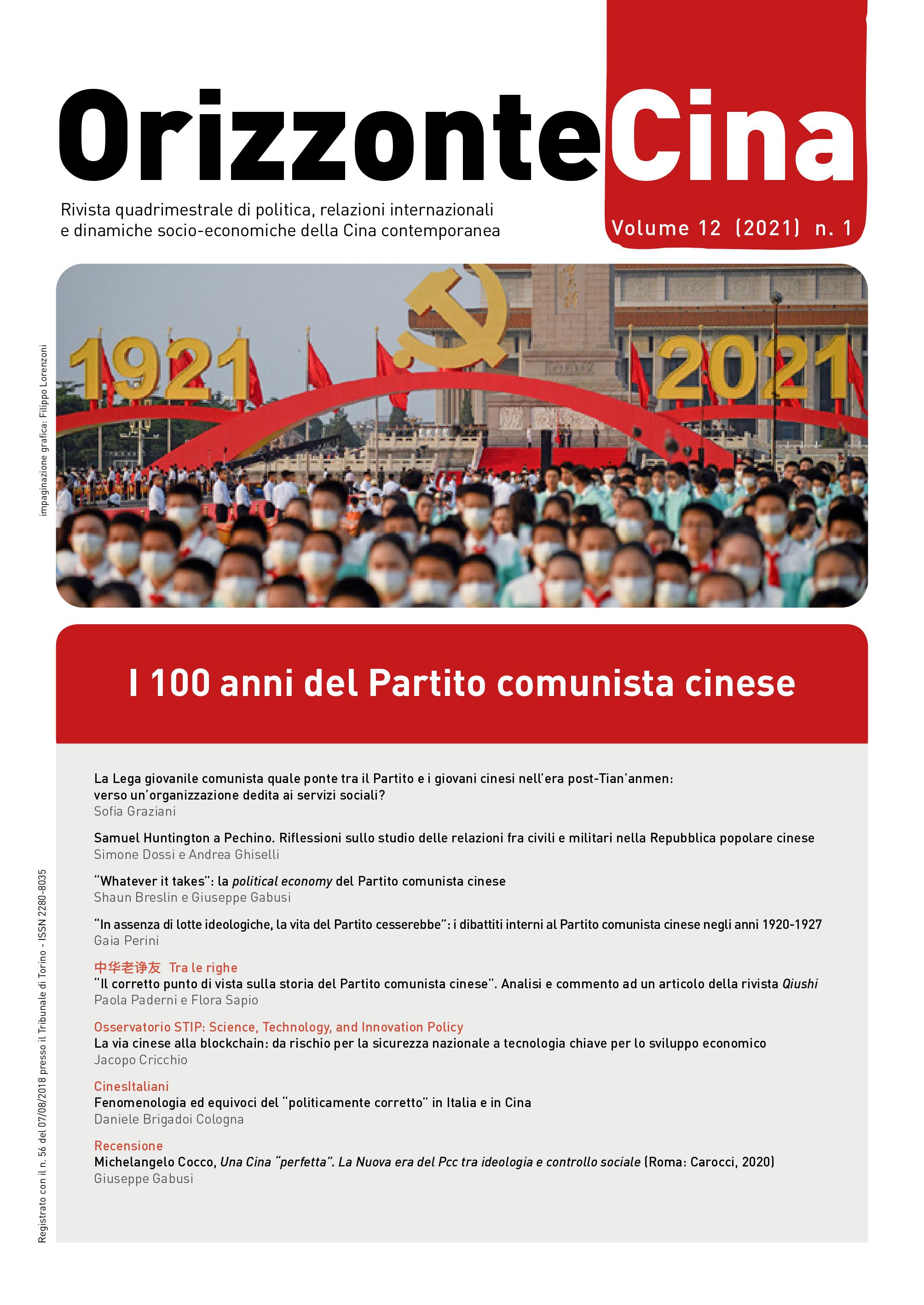
The 100 years of the Chinese Communist Party
Vol. 12 No. 1 (2021)Founded in 1921 in a phase of structural weakness and radical transformation of China, the Chinese Communist Party (CCP) is now leading the second world economy and is preparing to project the “Chinese approach” as an effective governance formula also beyond Chinese borders. These borders remain contested on various levels. On the internal institutional level, the structure of the “two systems in one country” has changed following the implementation of the National Security Law for Hong Kong. On the political-international level, the dialectic between Beijing and the West has brought the ideological component back to the fore, with repercussions on stability in the Taiwan Strait. As for identity-related aspects, the exertion of a more pervasive influence on the definition of the perimeter and of the characteristics that qualify “Chineseness”, especially with respect to national minorities and communities of the Chinese diaspora, places the CCP in a central position with respect to sense-construction and self-representation strategies, also of individuals and communities who do not necessarily own a passport from the People’s Republic of China.
At the same time, the strong growth of China’s “socialist market” economy and the response to the COVID-19 pandemic corroborate the political credibility of the CCP as an agent of modernization, both in the face of domestic public opinion and in countries aiming to the diversification of development strategies in addition to those envisaged by international institutions dominated by Western countries. The legitimacy based on the performance of the Chinese Leninist governance system in increasing the availability of material resources among the population is integrated by the repressive component, which determines the compression of the spaces of individual emancipation, free enterprise, social representation, and collective action not supervised by the CCP.
-
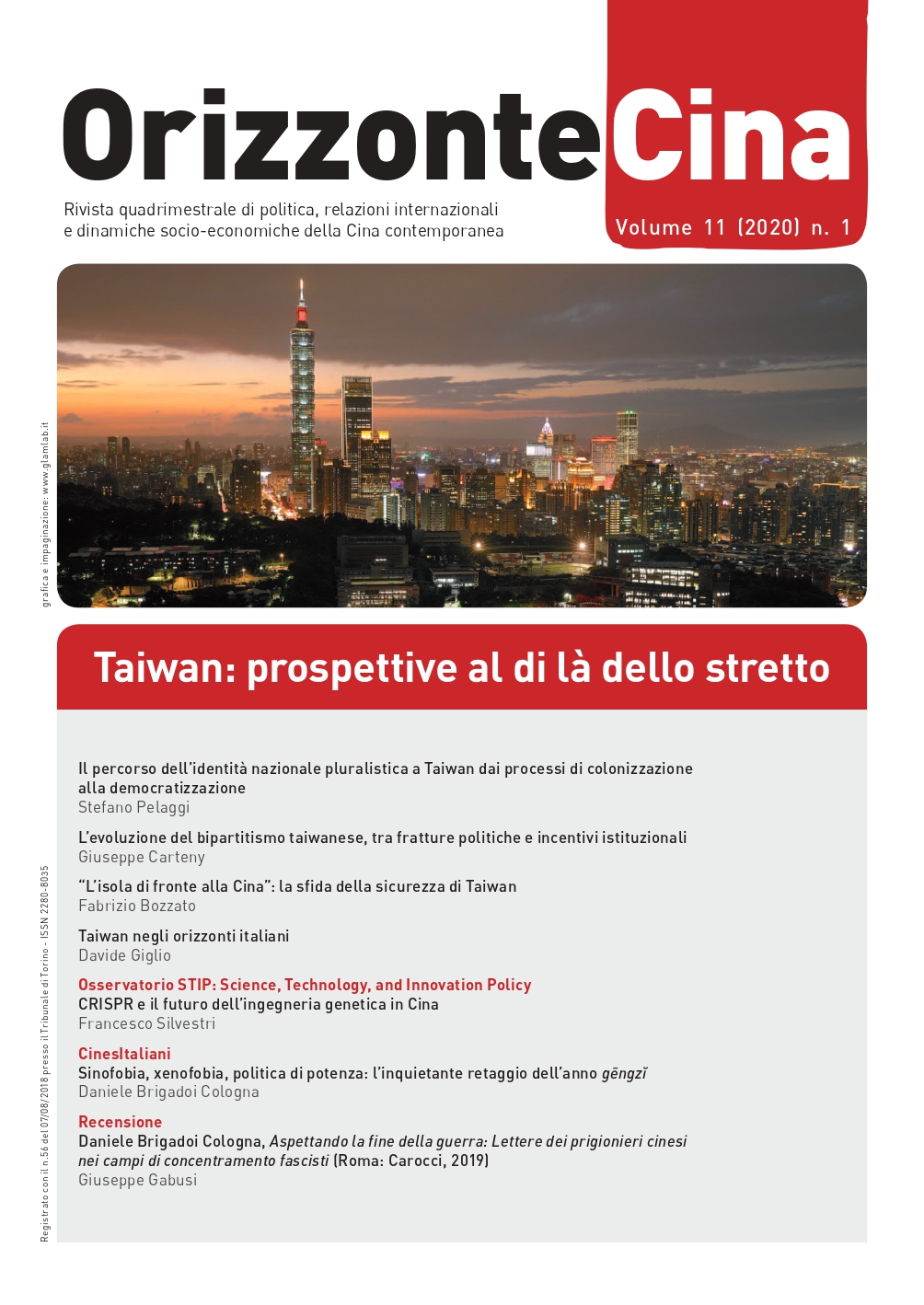
Taiwan: Perspectives Beyond the Strait
Vol. 11 No. 1 (2020)Taiwan, officially the Republic of China (Taiwan), is today one of the most vibrant democracies in the Far East, as well as an economic power of global significance. The complexity of its pluralistic identity framework, the political evolution it has undergone since the democratic transition of the 1990s, and the economic and security challenges to which it is exposed in the current delicate international political framework are key elements to be explored in order to understand the present and future balances in East Asia and beyond.
-
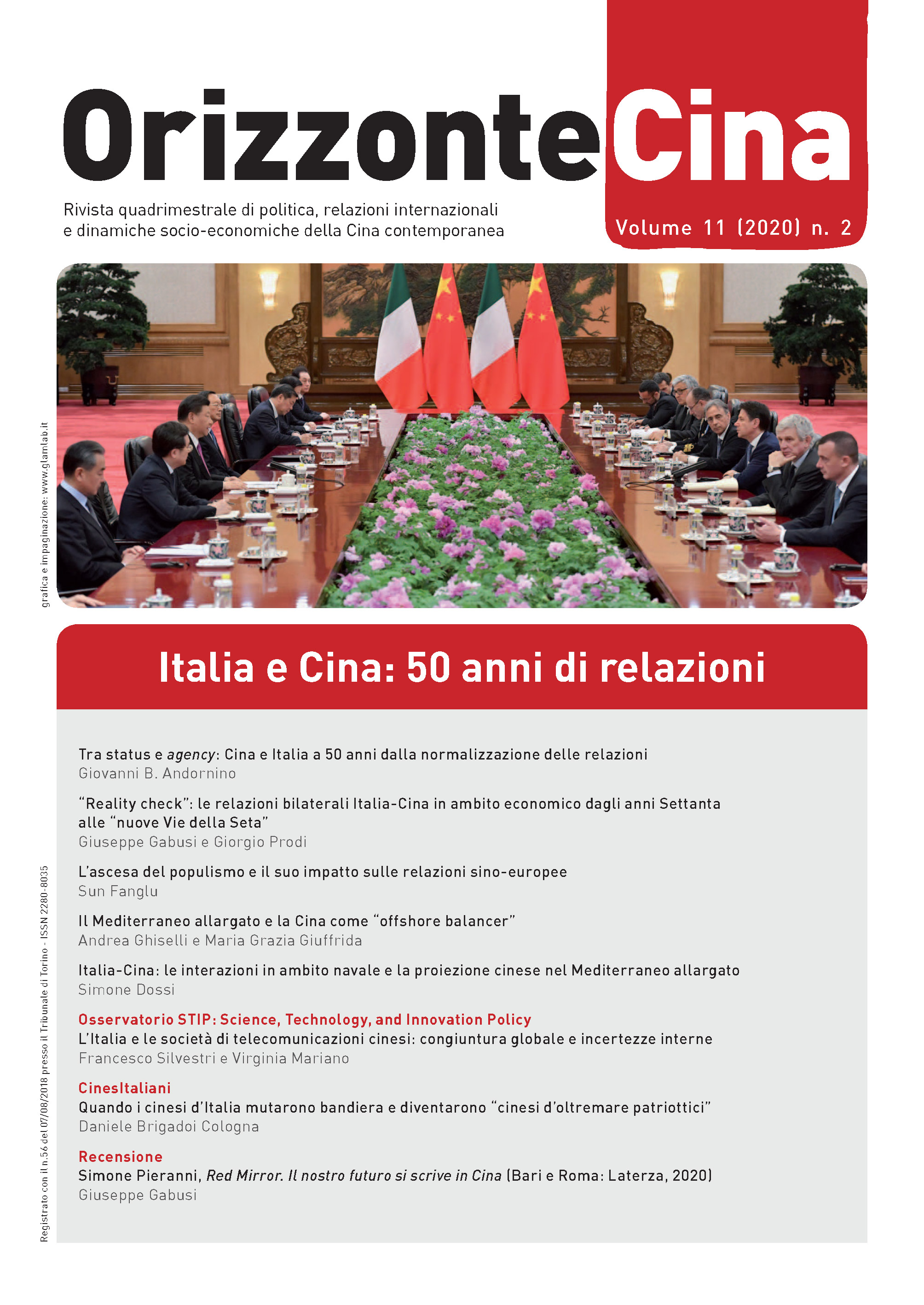
Italy and China: 50 Years of Relations
Vol. 11 No. 2 (2020)The 50th anniversary of the normalization of diplomatic relations between the Italian Republic and the People's Republic of China (6 November 1970-2020) coincides with a significant deterioration of the international political and economic framework. The COVID-19 pandemic, the effects of the "Jacksonian moment" on US foreign policy under the Trump administration, and the growing firmness of the European Union towards Beijing have accelerated the realignment of the factors that have enabled the agenda of "regeneration of the Chinese nation" pursued by the Chinese Party-State under the leadership of Xi Jinping. The statement issued at the end of the 5th plenary session of the 19th Central Committee of the Communist Party of China on 29 October 2020 reflects this awareness and signals how the leaders of the Party-State note a "profound change in the balance of international power". Particularly exposed after the signing of the Memorandum of Understanding for collaboration on the Belt and Road Initiative in 2019, Italy appears caught between the need to renew its agency on an international level through tangible and timely manifestations of authority and the risk of growing irrelevance disguised as consoling self-representations, not very effective in avoiding an uncomfortable position of subjection to the dialectic between the United States and China.
-
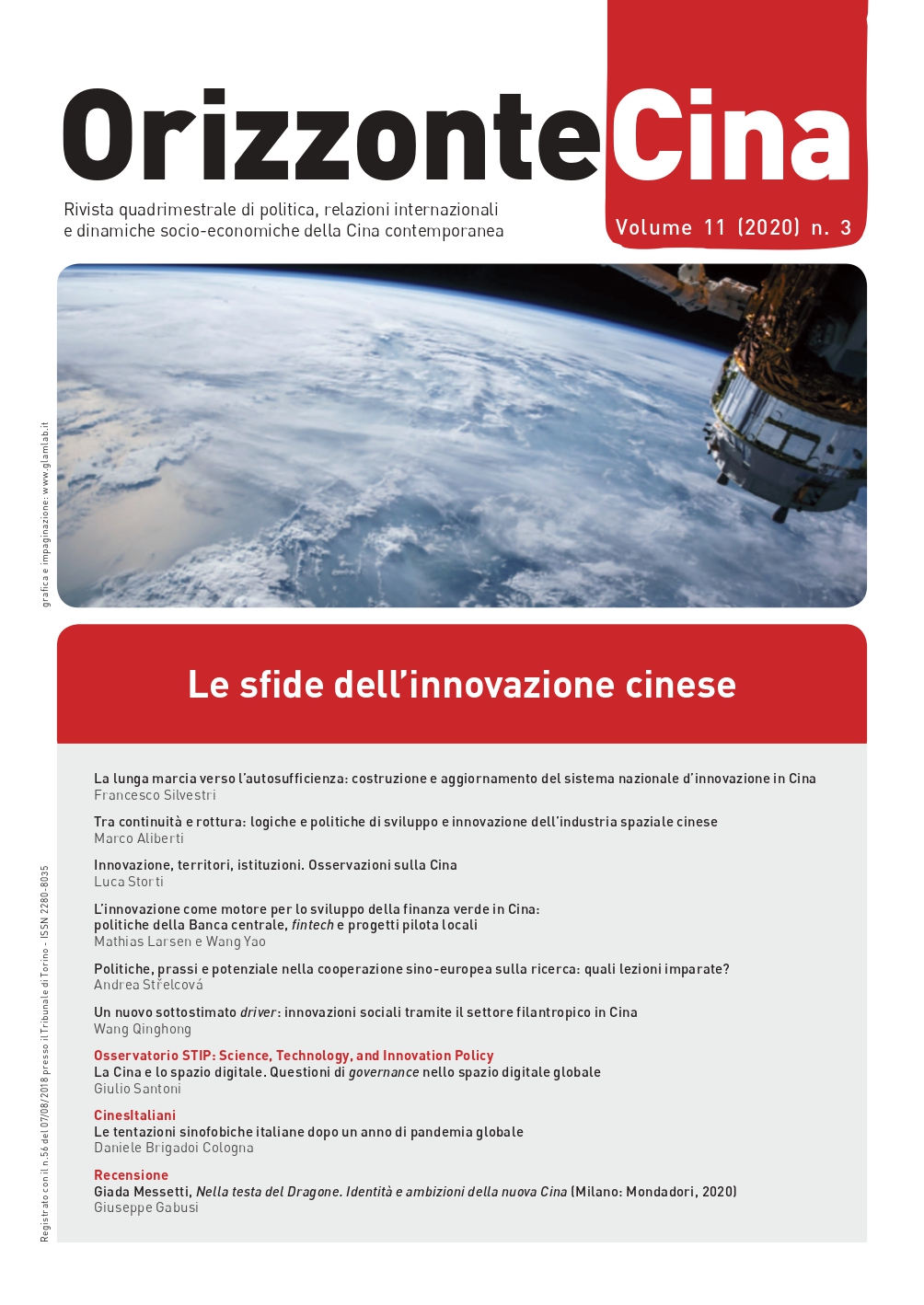
The Challenges of Chinese Innovation
Vol. 11 No. 3 (2020)The Fifth Plenum of the 19th CCP Central Committee, which gathered in October 2020, highlighted the role of science, technology and innovation (STI) as the country's driving forces to achieve a socialist modernization by 2035. China's path to building and consolidating its own innovation apparatus began in 1978 with Deng Xiaoping's reforms. What technological and innovation milestones and challenges await China in this new decade? Among space industry, digital spaces, fintech, research and philanthropy, the authors of this issue show how, for China, the path towards an innovation-driven development is already well underway.


